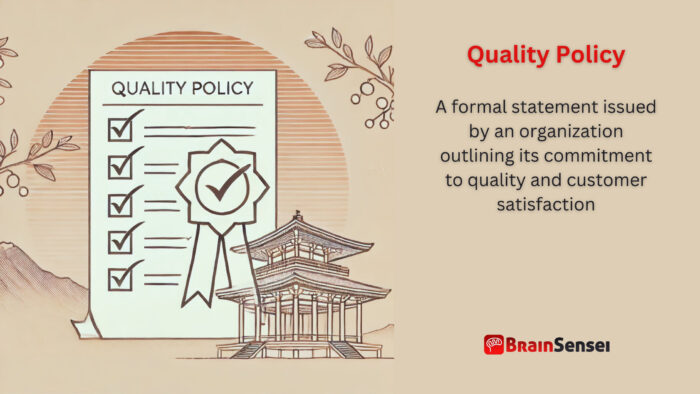
Quality Policy
What is Quality Policy?
A quality policy is a formal statement issued by an organization outlining its commitment to quality and customer satisfaction. It is a guiding principle for establishing quality objectives and ensuring continuous improvement. Typically aligned with international standards such as ISO 9001, a well-defined Quality Policy helps organizations maintain consistency, compliance, and excellence in products or services.
Key Takeaways
- Directs an organization’s quality management system (QMS)
- Defines commitments to meeting customer requirements and regulatory standards
- Serves as a foundation for establishing measurable quality objectives
- Reviewed periodically to ensure continued relevance and effectiveness
- Fosters a culture of continuous improvement and operational efficiency
Understanding Quality Policy
How It Works
A Quality Policy is a strategic document that influences an organization’s approach to quality management. It typically includes:
- Commitment Statement: A declaration of dedication to quality and compliance
- Customer Focus: Assurance of meeting or exceeding customer expectations
- Regulatory Compliance: Alignment with industry and legal requirements
- Continuous Improvement: Emphasis on ongoing enhancement of processes and services
- Employee Involvement: Encouraging team participation in maintaining quality standards
Organizations communicate their Quality Policies internally through training and documentation, ensuring alignment with company-wide quality objectives. They are also often made publicly available to demonstrate transparency and accountability.
Notes
- A quality policy should be clear, concise, and actionable to be implemented effectively.
- It must be aligned with business objectives and adapted to the organization’s size and industry.
- Leadership plays a crucial role in reinforcing and communicating the policy.
- It should include mechanisms for monitoring and evaluating performance against set objectives.
- Regular review and updates ensure the policy remains relevant and practical.
Related Terms
- Quality Management System (QMS): A structured framework of processes and procedures ensuring quality consistency and compliance
- ISO 9001: An international standard for quality management systems that provides a framework for improving organizational performance
- Total Quality Management (TQM): A holistic approach to long-term success through customer satisfaction and continuous improvement
- Process Improvement: Systematic efforts to enhance business processes efficiency, effectiveness, and consistency
- Regulatory Compliance: Adherence to laws, regulations, and industry standards governing quality and safety
- Customer Satisfaction: A key performance indicator (KPI) reflecting how well a product or service meets customer expectations
Examples of Quality Policy Implementation
Manufacturing Industry
A leading automobile manufacturer integrates a Quality Policy emphasizing defect prevention, regulatory compliance, and employee training. The policy supports a rigorous inspection process, reducing defects by 30% over five years. The company identifies and addresses inefficiencies in its production line. Employees undergo regular training sessions utilizing Six Sigma principles, ensuring they remain updated on the latest quality standards. The manufacturer experiences increased customer trust, fewer recalls, and improved market competitiveness through this approach.
Healthcare Sector
A hospital establishes a Quality Policy focused on patient safety and service excellence. This policy improves treatment outcomes and reduces medical errors. By healthcare standards, the policy mandates regular training for medical staff to ensure adherence to hygiene protocols and patient care guidelines. Furthermore, the hospital implements a patient feedback system for continuous quality improvement. Over time, patient satisfaction scores rise significantly, and the hospital earns accreditation from international healthcare organizations. The commitment to quality fosters a culture of safety and operational efficiency.
IT & Software Development
A software company adopts a Quality Policy centred on bug-free development and customer-centric solutions. By implementing agile methodologies, they achieve a 20% increase in software reliability. The company introduces rigorous testing phases, including unit testing, integration testing, and user acceptance testing. Additionally, developers follow coding standards that align with international best practices. Continuous feedback loops between development and quality assurance teams ensure quick issue resolution. The result is a more stable product, fewer post-release bugs, and increased customer retention.
Moreover, the company integrates customer feedback into future development cycles, ensuring software updates align with user needs. By adhering to its Quality Policy, the company establishes itself as a leader in delivering reliable software solutions, enhancing its reputation and client satisfaction.
Use Cases of Quality Policy Implementation
United States (Retail Industry)
A major retail chain implements a Quality Policy to ensure consistent customer experience across all locations. This policy guides employees on service standards and return policies, resulting in increased customer loyalty. The company uses performance metrics to monitor compliance with the policy, leading to improved service and fewer customer complaints. By investing in employee training programs, the company ensures that staff members understand quality expectations and deliver high-level customer service.
Germany (Automotive Manufacturing)
A German car manufacturer adheres to a strict Quality Policy aligned with ISO 9001. This policy ensures compliance with European safety regulations, helping the company maintain its reputation for high-quality vehicles. The company integrates quality checkpoints throughout the manufacturing process to detect defects early. Additionally, the company enforces supplier quality management programs to maintain consistency in raw materials. These initiatives increase customer satisfaction, lower defect rates, and reduce warranty claims.
India (Pharmaceutical Industry)
A pharmaceutical company in India integrates a Quality Policy to meet Good Manufacturing Practices (GMP). This policy helps in maintaining drug efficacy and regulatory approval. The company implements a stringent quality control process, including batch testing and compliance audits. Additionally, it adopts an advanced digital tracking system to ensure transparency in production. As a result, the company experiences fewer compliance violations, a more substantial reputation in global markets, and enhanced consumer trust.
By maintaining a strong Quality Policy, these organizations ensure long-term business success, customer satisfaction, and regulatory adherence.
Best Practices for Quality Policy Implementation
An effective Quality Policy is essential for maintaining high standards and achieving long-term business success. Here are some best practices organizations should follow:
Define Clear and Measurable Objectives
A strong Quality Policy should establish measurable goals that align with the organization’s mission. This goal includes setting key performance indicators (KPIs) for quality performance, customer satisfaction, and regulatory compliance.
Regular Employee Training and Awareness Programs
Employees must be well-informed about the Quality Policy and how it impacts their roles. Organizations should conduct regular training programs to ensure employees understand quality expectations, compliance standards, and continuous improvement initiatives.
Implement a Continuous Feedback and Improvement Mechanism
Quality is an ongoing process. Organizations should develop systems for collecting customer, employee, and stakeholder feedback. Then, they should use data-driven decision-making to identify areas for improvement and implement corrective actions.
Integrate the Quality Policy into Everyday Operations
The Quality Policy should not be static. Organizations must incorporate it into daily workflows. Businesses should integrate quality management tools such as Six Sigma, Lean Management, and Total Quality Management (TQM) to ensure consistency in operations.
Conduct Regular Audits and Performance Evaluations
Monitoring quality performance through periodic audits and reviews helps identify implementation gaps. Organizations should conduct internal and external audits to ensure industry standards and regulations compliance.
Foster Leadership Commitment and Accountability
Senior management must own the Quality Policy and lead by example. Leaders should actively participate in quality initiatives, reinforce policies, and provide resources for continuous improvement.
Enhance Supplier and Partner Collaboration
Quality does not solely depend on internal processes. Organizations should work closely with suppliers and partners to establish quality expectations, maintain consistency in raw materials, and ensure end-to-end compliance with quality standards.
Ensure Adaptability and Flexibility
Business environments are constantly changing, so the Quality Policy must be adaptable. Organizations should regularly review and update their policies to align with industry trends, regulatory changes, and customer expectations.
By following these best practices, organizations can ensure their Quality Policies remain relevant, effective, and beneficial to all stakeholders. This adaptability will enhance operational efficiency, improve customer trust, and sustain business growth.
Common Mistakes and Issues
One of the most common mistakes organizations make is failing to align their Quality Policy with their overall strategic goals. A too generic or vague policy often leads to ineffective implementation, as employees struggle to understand how it applies to their daily responsibilities. Clear, actionable guidelines are necessary to bridge the gap between policy and execution.
Another significant issue is the lack of employee engagement. Without proper communication and training, employees may not understand the importance of the Quality Policy, leading to inconsistencies in product or service delivery. Organizations should ensure that employees at all levels are aware of the policy and trained to implement it effectively.
Infrequent reviews and updates also pose a challenge. As industries evolve, regulations change, and customer expectations shift, a static Quality Policy becomes outdated. Companies that do not regularly assess and refine their policies may be non-compliant with industry standards or fail to meet customer demands.
Another significant issue is insufficient monitoring and auditing. A Quality Policy is only as good as the mechanisms in place to enforce it. Organizations that lack proper monitoring tools, such as key performance indicators (KPIs), audits, and feedback loops, may struggle to maintain consistent quality. Establishing a robust monitoring system ensures early identification of issues and opportunities for continuous improvement.
Ignoring customer feedback can be detrimental. Customer expectations often define quality, and failing to incorporate customer insights into the Quality Policy can result in dissatisfaction and loss of business. Companies should implement structured feedback mechanisms like surveys and reviews to capture customer perspectives and integrate them into quality improvements.
Lastly, poor leadership commitment is a critical issue. Organizations must drive the Quality Policy from the top, with senior management demonstrating a clear commitment to its principles. If leadership does not actively promote and reinforce the policy, employees may perceive it as unimportant, leading to weak adherence across the organization.
Addressing these common mistakes can strengthen organizations’ Quality Policies, ensuring they remain practical tools for achieving excellence in products and services.
Frequently Asked Questions (FAQs)
Why is a Quality Policy critical?
A Quality Policy establishes a company’s commitment to maintaining high standards, ensuring customer satisfaction, and meeting regulatory requirements.
How often should a Quality Policy be reviewed?
Organizations must review the Quality Policy annually or whenever significant changes in business operations or regulations occur.
Who is responsible for enforcing the Quality Policy?
Leadership, management, and employees share responsibility, with senior executives ensuring alignment with organizational goals.
How does a Quality Policy align with ISO 9001?
ISO 9001 requires a documented Quality Policy to define objectives, ensure compliance, and drive continuous improvement.
Can small businesses benefit from a Quality Policy?
Small businesses can enhance efficiency, customer trust, and regulatory compliance through a well-defined Quality Policy.
Additional Resources
Preparing for a PMI certification?
- Exam Prep Courses: PMP®, CAPM®, and PMI-ACP®
- Exam Simulators: PMP®, CAPM®, PMI-ACP®, PMI-PBA®, PMI-RMP®, PMI-SP®, PgMP®, and PfMP®
- Professional Development Units (PDUs): 15, 30, and 60 PDU Bundles



